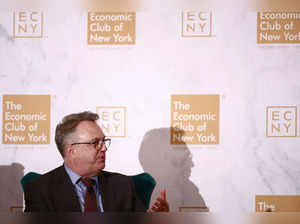 Reuters
Reuters“(US) Inflation is now around 2-1/2 percent, so we have seen significant progress in bringing it down. But we still have a way to go to reach our 2 percent target on a sustained basis. We are committed to getting the job done,” Williams said while delivering the fourth Suresh Tendulkar Memorial Lecture at the Reserve Bank of India on Friday.
Latest US data showed that the personal consumption expenditures price index – the Fed’s preferred price gauge- climbed 2.6% on a year-on-year basis in May.
Williams, a voting member of the Federal Open Market Committee – the US rate-setting panel – said that his views were personal. The central banker emphasised that uncertainty in monetary policy would continue for some time, given the volatile global environment.
“I’ll look at the path of the New York Fed’s Global Supply Chain Pressure Index, which gauges global supply-chain disruptions. By late 2021, it rose to more than four standard deviations above the historical average. It finally returned to normal levels last year,” he said.
“To put the rarity of such events in perspective, a single four-standard-deviation event would occur about once every 2,500 years based on a standard normal distribution.”
Speaking about the much-debated neutral rate of interest, or “R-star”, Williams said that the factors that had contributed to a higher neutral rate of interest a year ago were now changing course. The neutral rate of interest represents the level at which monetary policy is neither tight nor loose. Theories about the level at which the Fed may consider the neutral rate of interest as appropriate have abound over the past year, as has accompanying speculation as to whether rates would remain higher for longer or come down in the foreseeable future.
“But in the US, what we see now is – we’re seeing growth slow, we’re seeing inflation come down quite a bit, interest rates haven’t come down, so, the constellation of factors that made the R-star look higher now are in the process of reversing,” he said. A higher neutral rate has often been thought to imply stronger economic growth and therefore a cause for policy rates to be elevated.
In response to a question about potential political pressures on the Fed’s policy making ahead of the US elections in November, Williams said that the central bank would always focus on the best decisions for the US and global economy and had the independence to make tough decisions “that may not be popular in the short-run.”
(Catch all the Business News, Breaking News, Budget 2024 Events and Latest News Updates on The Economic Times.)
Subscribe to The Economic Times Prime and read the ET ePaper online.
Read More News on
(Catch all the Business News, Breaking News, Budget 2024 Events and Latest News Updates on The Economic Times.)
Subscribe to The Economic Times Prime and read the ET ePaper online.









 Get Unlimited Access to The Economic Times
Get Unlimited Access to The Economic Times
